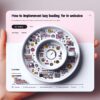Making the Most of Your Website’s Header Section

So, you have decided to take a plunge into the world of web development? Awesome! Give yourself a pat on the back because it’s time to embark on an exciting journey. Don’t worry, you’re not alone on this. I am here to guide you through it – like a wise old wizard guiding a young hobbit on an epic adventure. Now, let’s put on our coding hats (yes, you get a hat now!) and dive right in.
Today, we’ll be discussing a topic as important as a Smaug is to a pile of gold – Making the Most of Your Website’s Header Section. After all, the first impression is the last impression – it doesn’t matter if you are meeting your girlfriend’s parents for the first time or creating a website.
Understanding the Header
Imagine entering a house where shoes are hung as chandeliers. Not really welcoming, amiright? That’s the same thing with a website. Your header is essentially the “front porch” of your website. It sets the stage for what is to come.
Your header needs to set the tone, give a clear idea of your website’s purpose, and most importantly, be welcoming. If your visitors are lost in your header, they’re likely to get frustrated and leave before exploring the rest of your digital castle. Remember, a confused mind always says no!
Key Elements of an Effective Header
Logo and Branding
Your logo is like the superhero insignia of your brand. It’s the marker that silently screams, “Yes, you’re in the right place. Welcome home, friend!” Make sure your logo is prominently placed in your header for instantly recognizable branding.
Navigation
If your website was a city, your navigation system would be its helpful street signs. People should be able to find their way around with ease. Your navigation links should be clearly defined and easily accessible in your header section.
CTA – Call to Actions
A CTA is like asking out your crush. You need to be direct and clear about your intentions. Including a main call-to-action in your header can help guide visitors to important areas or actions on your site.
Tips for Making Your Header Rock
Keep it Simple, Silly
As Leonardo Da Vinci said, “Simplicity is the ultimate sophistication.” Or maybe it was Steve Jobs. Either way, it applies to headers as well! Don’t clutter it up with unnecessary elements. Pick what’s important and let go of the rest.
Responsive and Mobile Friendly
Since more people use smartphones than speak Klingon, make sure your header is mobile-friendly. A responsive header adjusts to different screen sizes, ensuring a good user experience regardless of the device.
Headers Love SEO too
Optimize your header for search engines by utilizing key phrases and tags. Today’s mantra is “Nothing gets past Google, not even your Web Header!”
There you have it, brave web developer in making! Now that you’re loaded up with all this knowledge, go forth and conquer the web development world. Don’t forget, like any Jedi Master would tell you, “practice makes perfect.”
So, you might not get it all right on your first try, but remember, even Batman needed time. And hey, if you still get stuck, you always have me, your wise old wizard, right here.
Until next time, code on, my friend. Code on!
FAQ
What is the purpose of the header section on a website?
The header section is the top portion of a website that typically includes the site’s logo, navigation menu, and important information to help visitors easily navigate the website and understand its purpose.
How can I make my website’s header stand out?
You can make your header stand out by using a visually appealing design, incorporating eye-catching graphics, choosing a unique color scheme, and ensuring that the content is concise and effective.
Should I include a call-to-action in the header section of my website?
Yes, including a call-to-action in the header section can help prompt visitors to take a specific action, such as signing up for a newsletter, making a purchase, or contacting your business.
Is it important to ensure that the header is responsive on all devices?
Absolutely! Ensuring that your header is responsive means that it will look and function well on desktops, tablets, and mobile devices, providing a consistent user experience regardless of the screen size.
How can I optimize my website’s header for search engines?
To optimize your header for search engines, make sure to include relevant keywords, use semantic markup for elements like headings, and provide descriptive alt text for images within the header section.
Should I include social media links in my website’s header?
Including social media links in the header can help increase your online presence and make it easier for visitors to connect with you on different platforms, so it’s generally a good idea to do so.
Can I use a sticky header on my website?
Yes, a sticky header stays fixed at the top of the screen as users scroll down the page, ensuring that important navigation options are always accessible. Just be mindful of the impact on usability and mobile responsiveness.
How can I incorporate multimedia elements into my website’s header?
You can enhance your header using multimedia elements like videos, animations, or interactive sliders to grab visitors’ attention and showcase your brand in a dynamic way. Just remember to keep them relevant and not overly distracting.
What is the role of typography in the header design?
Typography plays a crucial role in the header design by setting the tone, conveying information, and improving readability. Choose fonts that align with your brand identity and make sure the text is legible across different devices.
Are there any common pitfalls to avoid when designing a website’s header?
Some common pitfalls to avoid include cluttering the header with too much information, using poor color contrasts that affect readability, neglecting mobile optimization, or creating a header that doesn’t match the overall style of your website.
Categories


